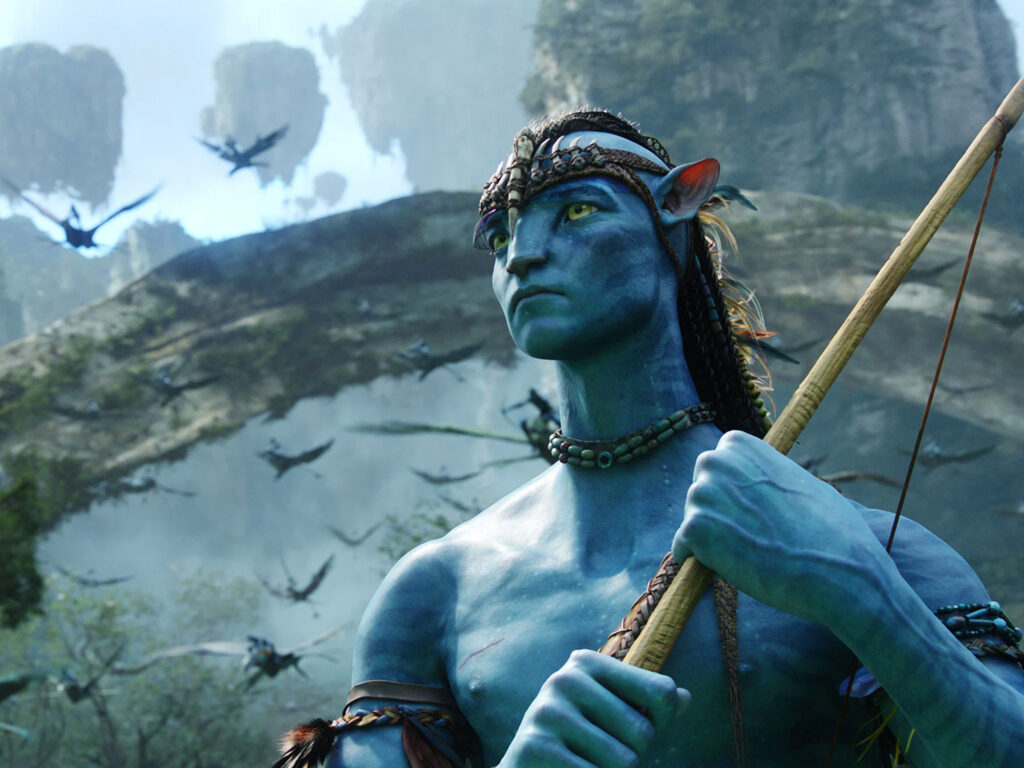
James Cameron’s Avatar: The Way of Water is a movie full of miracles—floating mountains, underwater trees, resurrected warriors, talking whales—but perhaps the most miraculous thing about it is that it exists at all. With more than a decade spent in mysterious development, its hypothetical completion and release became something of an industry joke—the cinematic equivalent of hell freezing over. Yet defying the odds has long been Cameron’s forte; remember, Titanic was a colossal boondoggle until it became the biggest movie in the world, and the original Avatar was initially anticipated to be a misbegotten foray into motion-capture extravagance before it dethroned Titanic and attained box-office supremacy. (Until Star Wars: The Force Awakens came along, financial analysts resorted to qualifying new hits as setting records among movies “not directed by James Cameron.”) Now, 13 years later, the self-proclaimed king of the world has finally emerged from the oceanic depths with a sequel, and it’s both exactly what you expected and more than you could’ve imagined: repetitive, eye-popping, clunky, spectacular. Strictly speaking, The Way of Water may not be better than Avatar—which, to be clear, is fantastic—but there is certainly more of it.
In a sense, Cameron’s triumph here is limited, even as it’s also boundless. His reputation as a cinematic pioneer remains intact—he once again channels his instinctual pop savvy and his extraordinary grasp of technology to conjure images, environments, and sequences that have never before been glimpsed on screen—yet his innovation is still exclusively (if exquisitely) visual. From a storytelling standpoint, he prefers to mine familiar terrain. If Avatar was derivative of a dozen prior adventure epics (it’s Dances with Wolves! it’s Pocahontas! it’s FernGully!), The Way of Water is derivative of Avatar. Once again, the native Na’vi—those twelve-foot blue-skinned forest-dwellers who are indigenous to the bountiful planet of Pandora—find themselves under attack by marauding human invaders. There are minor tweaks—instead of installing a mining operation, the colonizers now seek to permanently inhabit Pandora in light of Earth’s impending ecological demise; rather than extracting the precious mineral “unobtanium,” venal poachers now hunt down giant sea beasts to secure a priceless enzyme that prevents people from aging—but the movie’s central conflict remains largely uncomplicated: The Na’vi and the humans are still at war, and the good guys—led by Jake Sully (Sam Worthington), the former Marine who defected after he fell in love with the beautiful and fearsome Neytiri (Zoe Saldaña)—are the ones in blue.
Well, mostly. Also returning is Colonel Miles Quaritch (Stephen Lang), the bellicose military commander whom Neytiri killed in the climax of the first film. Whether because Cameron lacked the imagination to invent a superior villain or because he simply valued the sneering charm of Lang’s performance, he and his co-writers (Rick Jaffa and Amanda Silver) have contrived to revive Quaritch, though his consciousness now resides inside the lithe body of a Na’vi avatar. This would seem to set the stage for an identity crisis, but it’s really about leveling the combative playing field; Quaritch leads a troop of deceased grunts who have similarly transformed into feral avatar mercenaries, and their mission is to destabilize the Na’vi by assassinating their leader, a salty soldier who just happened to take orders from Quaritch once upon a time.
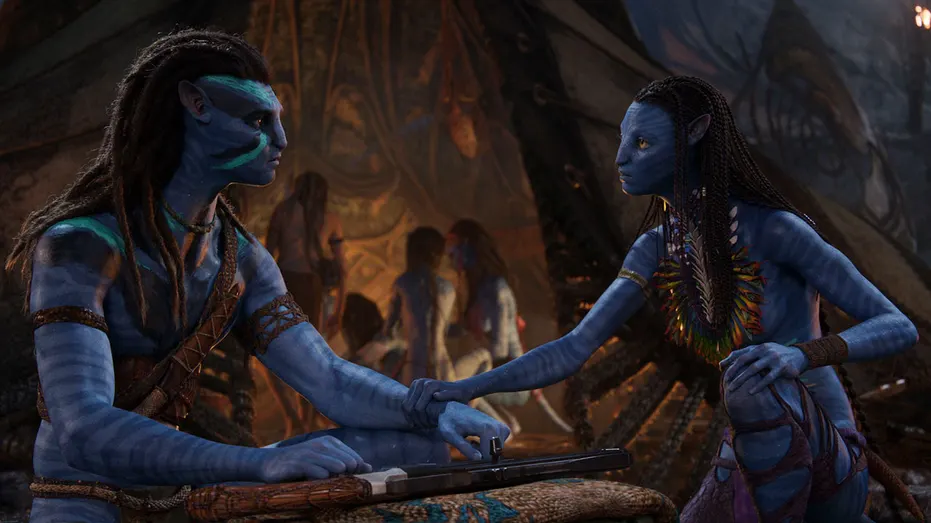
The familiarity of this simmering battle is slightly deflating; for its first hour or so, The Way of Water plays a bit like Avatar Redux. It mostly affords Cameron time to flaunt the advances he’s made in the past decade, not all of which are welcome. He’s chosen to exhibit his new production in a high frame rate, which streamlines the characters’ movements and artificially speeds up the playback, often akin to that infernal motion smoothing setting on modern TV sets. Maybe it’s just because my brain has been conditioned to process motion pictures shot at 24 frames per second, but I’ve never liked HFR, as it tends to result in a glossy, plastic-looking image that favors fluidity over realism. (The worst offender in this regard remains Ang Lee’s catastrophic Gemini Man, which cranked things up to 120 fps and looked like an extremely expensive soap opera.) I can fathom Cameron’s justification here—the Na’vi aren’t human, so there’s no need to make them move like humans—but the tech is still needlessly distracting; it also isn’t applied consistently, meaning that more typical scenes end up looking slow and juddery by comparison. (In contrast, Cameron’s use of 3D remains brilliant and unparalleled, invisibly pulling you into his frame rather than bombarding you with flying objects; Pandora’s forests feel so enveloping, you’re liable to sense massive trees looming behind you.)
Still, even if I never fully accepted the HFR in The Way of Water, it also never ruined my appreciation of the movie’s action, simply because Cameron’s orchestration is so elegant and exhilarating. The film’s first major set piece, in which Jake, Neytiri, and their children (we’ll get to them) face off against Quaritch’s forces in a rippling wood, hums with danger and excitement. It also results in the first major plot pivot: Convinced that his presence among his people will continue to attract Quaritch’s bloodlust and imperil the rest of his tribe, Jake insists that he and his family flee the forest and take shelter with the Metkayina, a clan of reef-dwellers. And once The Way of Water transports itself to the sea and dives under the surface, the movie truly takes flight.
The second hour of The Way of Water, in which Cameron chronicles our heroes’ assimilation into the Metkayina—while also periodically cross-cutting to Quaritch’s corresponding efforts to master his new avatar form—is probably the gentlest, most beautiful filmmaking he’s ever done. He has long been obsessed with the ocean, constructing entire blockbusters (The Abyss, Titanic) around its deadly allure, but he has never plunged into its depths with such ravishing élan. Simple scenes of aquatic exploration glow with lustrous color (the cinematographer is Russell Carpenter), creating a breathtaking bioluminescence; in addition to his trademark blue, Cameron supplies new hues of green and purple, along with a dazzling streak of bright orange.
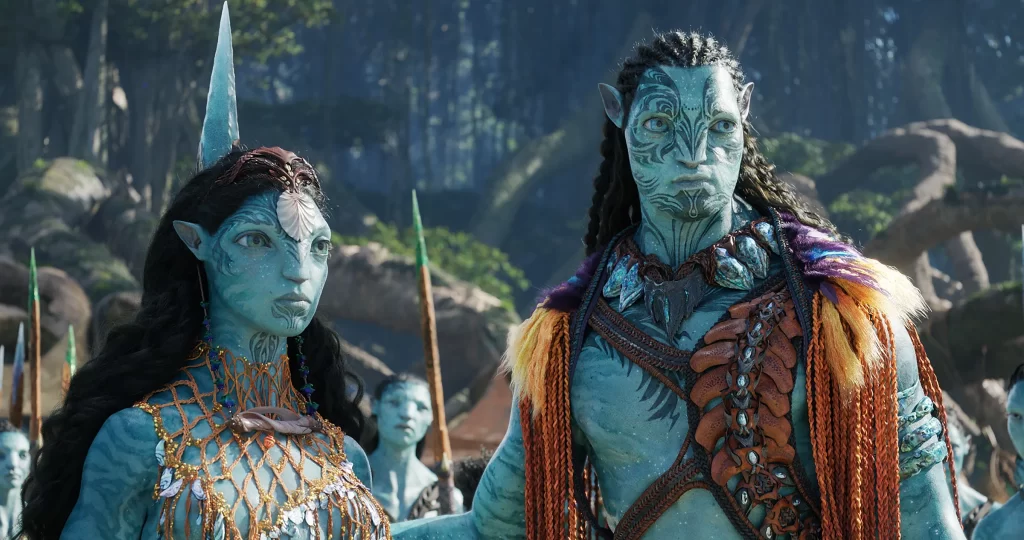
Yet the movie’s astonishment derives from more than just supple lighting and careful craftsmanship. (The rich production design is by Dylan Cole and Ben Procter; the booming, Horner-esque score is courtesy of Simon Franglen.) The underwater sequences move with such powerful confidence, such graceful vigor, they seem to invent a new cinematic language altogether, even as they clearly carry tangible weight. The process of their creation was doubtless groundbreaking (and, per press reports, quite arduous), but watching these scenes, we aren’t busied with idle “How did they do that?” musings; instead, we melt into the screen, staring in wonder as Jake attempts to bond with a racing sea creature or as his son finds kinship with a mammoth mammal that resembles a hyper-intelligent species of whale.
About that son. Jake and Neytiri actually have two: Neteyam (Jamie Flatters), a sturdy lad comfortable with shouldering responsibility, and Lo’ak (Britain Dalton), a sulkier teenager who chafes under his father’s rigid regime. They also have two daughters: the young Tuk (Trinity Jo-Li Bliss), a precious hanger-on who’s invariably in need of rescuing, and the yellow-eyed Kiri, a perpetually curious explorer who was mysteriously (one might say conveniently) born from the lifeless avatar of Jake’s deceased friend Grace; her adoption into Jake and Neytiri’s family allows Cameron to create a new part for his old pal Sigourney Weaver. (As Quaritch’s return demonstrates, death can be frustratingly impermanent in blockbuster cinema, though Cameron does exhibit the resolve to kill a key character here.) Also in the fold is Spider (Jack Champion), a human boy who, thanks to a few logistical contrivances, has been raised alongside the Na’vi, even as he proves to be the biological son of a certain scowling colonel.
Thematically, then, The Way of Water is a movie about parenthood—its rewards, its challenges, its complexities and anxieties. Jake’s hardwired tendency toward protection, which is both understandable and overbearing, places him in constant tension with Lo’ak, who yearns to substantiate his masculine bona fides—typically by hurling himself into needless danger. For her part, Kiri senses an elusive spiritual link with her lost mother, yet her pursuit of this connection creates grave risks to both her own health and her family’s seclusion. And Spider is the classic example of a child caught between warring worlds; neither Na’vi nor human, he wrestles with his loyalty to his surrogate relations even as he wonders about the possibility of a burgeoning bond between himself and his long-absent father.
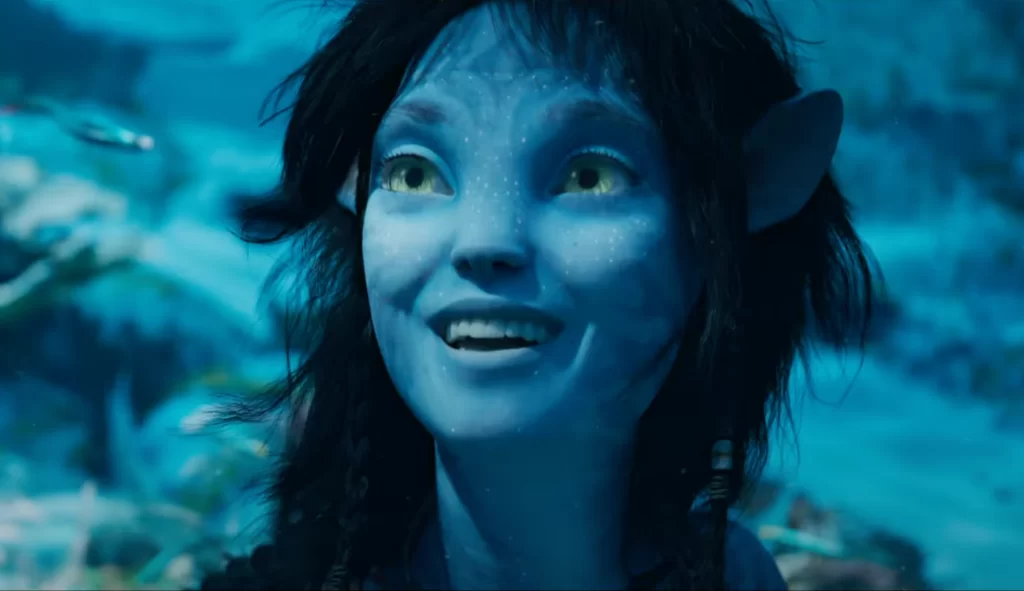
Cameron has never been a subtle storyteller (did I mention that new villains emerge in the form of amoral whalers?), and the tribulations of his teenage characters here verge on kid-lit conventionality. (Readers of Star Wars fiction may perceive an affinity with the “Young Jedi Knights” novels.) Certain moments, as when several Metkayina youths bully Lo’ak before goading him into recklessness, are groaningly predictable. (Lo’ak also expresses pubescent interest in the chief’s daughter, and their freighted glances are a reminder that Cameron can be slick with exposition, at least when he doesn’t resort to blunt voiceover.) But just because the film spends a good deal of time with children doesn’t make it childish, and Cameron’s robust staging of various sequences—in particular Lo’ak’s nervy venture into the belly of the beast, along with Kiri’s linkage with a mythical plant—overpowers typical coming-of-age tropes.
Besides, any concerns about commonality vanish once the movie enters its thrilling third act. Where most contemporary blockbusters wilt in their big set pieces, mistaking clattery green-screened chaos for genuine wonder, Cameron has made a living doing the opposite; he knows how to build anticipation, and how to pay it off with a mix of intelligence and gusto. His greatest feat in this regard remains the finale of Titanic, which somehow turned real-world tragedy into fictional spectacle that was kinetic, suspenseful, and wrenching.
If The Way of Water doesn’t quite reach that apex, or even the dizzying heights of the first Avatar, its culminating sequences are nonetheless magnificent. Cameron recognizes the value of legible choreography, and while the special effects on display are remarkable, they aren’t overwhelming; we can always see what’s happening, and to whom. (It helps that he’s once again smart enough to set most of his high-octane mayhem in daylight.) Even if most of the combatants are products of Cameron’s famed motion-capture process, they nevertheless occupy real physical space, meaning the action possesses palpable impact. And while much of the carnage involves animals of various shapes, sizes, and colors meting out vengeance on cruel and hapless interlopers (the film’s lone 3D-related indulgence involves a severed arm, the slicing of which elicited cheers at my screening), Cameron boldly throttles down for the true climax—a fraught and electric confrontation that carries real stakes and seethes with pulse-pounding quiet.
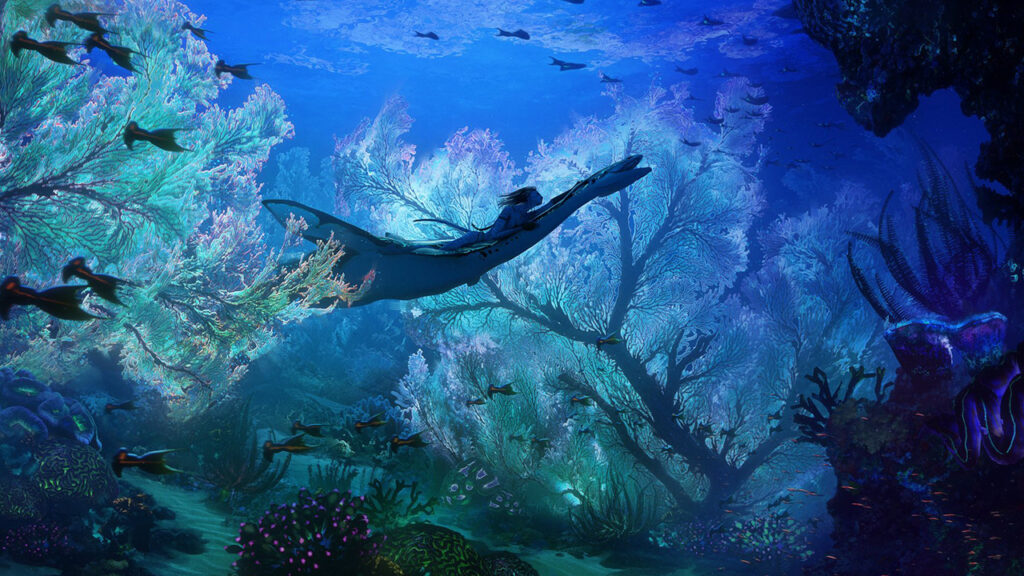
That scene works not just because of the lucid compositions, but because we’re invested in the characters, despite their limited dimensionality. (It also briefly showcases the talent of Saldaña, whose patented snarl bristles with real lethality.) I suspect that some viewers will watch The Way of Water and be tempted to dismiss it as mere pageantry—a grandiose production that sacrifices basic fundamentals in the pursuit of technical amazement. The visuals are great, the story is mediocre, so it’s a wash.
While I understand that reading, I emphatically reject it. It diminishes not only the staggering scale of Cameron’s aesthetic achievement—which, I might remind, operates in the realm of cinema, also known as a visual medium—but also the degree of propulsion he brings to the film’s narrative. Sure, The Way of Water is long, goofy, and obvious; it is also energetic, satisfying, and sincere, and its unapologetic corniness is disarming. Here is a science-fiction blockbuster in which rapacious hunters wage war against defiant natives who can literally communicate with their beloved environment; it may be simplistic, but it still amasses an elemental power, one that’s augmented exponentially thanks to the gifts of its creator.
The great irony of James Cameron’s career is that he’s spent most of it helming cautionary tales about the potential evils of technology (the Terminator pictures, Aliens, now the Avatar-verse), yet those tales acquire force precisely because he wields the most advanced technology imaginable. This doesn’t strike me as inconsistent, but as an honest expression of his faith—in his art, in his species, in himself. He believes that people can do great things, so long as their hearts remain pure.
What nonsense, what hokum! Avatar: The Way of Water won’t change the world; it probably won’t even change the movies. But it is here, in all its resplendent, kooky, operatic glory. It’s been quite the journey; shooting one scene, the great Kate Winslet, who plays a Metkayina chieftainess, reportedly submerged herself without oxygen for over seven minutes. That’s outrageous, but I’m strangely unimpressed. After all, I myself spent the vast majority of this deeply silly, enormously enjoyable 192-minute movie holding my breath.
Grade: A-
Jeremy Beck is the editor-in-chief of MovieManifesto. He watches more movies and television than he probably should.
